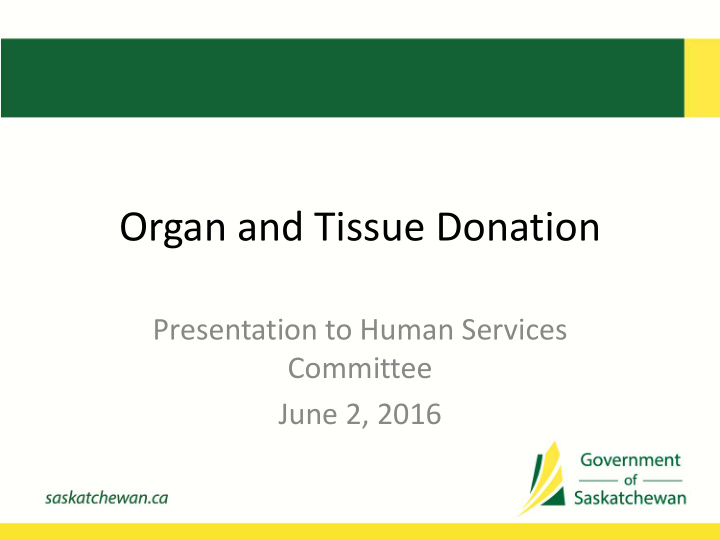



Organ and Tissue Donation Presentation to Human Services Committee June 2, 2016
Why organ and tissue donation? • Organ donation saves lives and dramatically improves quality of life. – One donor can save up to 8 lives and enhance 75 more through tissue donation • You are six times more likely to need a transplant than to become an organ donor
Saskatchewan context • Saskatchewan programs support; – 469 individuals in Saskatchewan living with a kidney transplant – 73 liver transplant patients – 42 lung transplant patients – 34 heart transplant patients – 13 pediatric transplant patients • These numbers do not include Saskatchewan residents being supported by programs in other provinces
Supply vs. Demand Canadian organ donation Supply vs. demand 2005 - 2014 5000 4500 4000 3500 3000 Donors 2500 Persons transplanted 2000 Persons on waitlist 1500 1000 500 0 2005 2006 2007 2008 2009 2010 2011 2012 2013 2014 Source: Canadian Blood Services
What may be donated Organs include: Tissues include: Heart Heart valves Lungs Corneas Liver Tendons & Ligaments Kidneys Bone Pancreas Amniotic membrane Skin • Living organ donors: – donate a kidney, lobe of liver or lobe of lung
Deceased donor criteria • Current state: – Potential donors are in critical care units of hospitals and emergency rooms meeting the following “GIVE” criteria: • Gl asgow Coma Scale < 5 • I njured Brain • V entilated • E nd of life discussion • Across Canada, only 1 to 2% of hospital deaths meet these criteria
7 sources & limitations - refer to data notes page
International Deceased Donation Rates 2013 International Registry in Organ Donation and Transplantation www.irodat.org/?p=database
High performing donation systems • Typically include the following; – Donor coordinators – Donation physicians – Online intent-to-donate – Medical record review to identify missed opportunities – Mandatory referral – Standard clinical triggers – Implementation of leading practices, professional education – Timely performance data & transparency – ICU/hospital capacity – Organ donation organization funding – National coordinating authority
Current state in SK • The Saskatchewan Chronic Kidney Disease Program steering committee, which includes reps from the Kidney Foundation, physician specialists, regional health authorities, the FSIN and the Ministry provides advice. • In November 2013, the committee recommended improvement in the rate of organ donation and kidney transplantation through consideration of the following: – Update The Human Tissue Gift Act – Policy of mandatory referral of imminent hospital patients to the organ donor coordinators – Develop processes so that the system recognizes the organ donor sticker – Develop Donation after Cardio-circulatory Death (DCD) program – Donor physician champions in Intensive Care Units – Organ Donation tracked by senior leadership as a key performance indicator
Current state in SK • Third reading of The Human Tissue Gift Act occurred April 28, 2015 • Allows regulations to be developed • In addition to those directly involved in the service, those consulted include advocacy groups (e.g. Kidney Foundation, Lung Association), regulatory bodies (College of Physicians and Surgeons, SRNA), and RHAs
Development of regulations • Preliminary consultation document that will form the regulations has been drafted: – Mandates referral of a hospital death or pending death to organ donor coordinators in tertiary and regional hospitals so that opportunities for donation are not missed. – Allows other hospitals and special care homes to refer – Allows payments to other jurisdictions for the cost of processing a cornea or importing corneas from the United States.
High performing donation systems • Typically include the following; – Organ donor coordinators – Mandatory referral – Standard clinical triggers – Implementation of leading practices, professional education – Timely performance data & transparency – Donation physicians – Online intent-to-donate – Medical record review to identify missed opportunities – ICU/hospital capacity – Organ donation organization funding – National coordinating authority
14
Opportunities • Opportunities to increase donation rates in Saskatchewan include: – Expansion of donation after cardiocirculatory death – Donation among older donors – Provincial conversion rates and deceased donor profiles – Organization of hospital care – Presumed consent & opt-out registry – Donation physicians – Online intent-to-donate – Medical record review to identify missed opportunities – ICU/hospital capacity – Organ donation organization funding – National coordinating authority
International Deceased Donation Rates 2013 Countries with presumed consent International Registry in Organ Donation and Transplantation www.irodat.org/?p=database
Consideration of opportunities • Thorough review of the utility of each of these opportunities needs to be conducted, particularly in the Saskatchewan context – E.g. intent to donate registries are not necessarily good indicators of organ donation rates, have significant costs, and little demonstrated impact • A multi-faceted systems approach is required to significantly impact organ and tissue donation rates.
Contact information • Thank you Deborah Jordan Saskatchewan Ministry of Health Executive Director, Acute and Emergency Services 306 787 7854 Deborah.jordan@health.gov.sk.ca
Recommend
More recommend